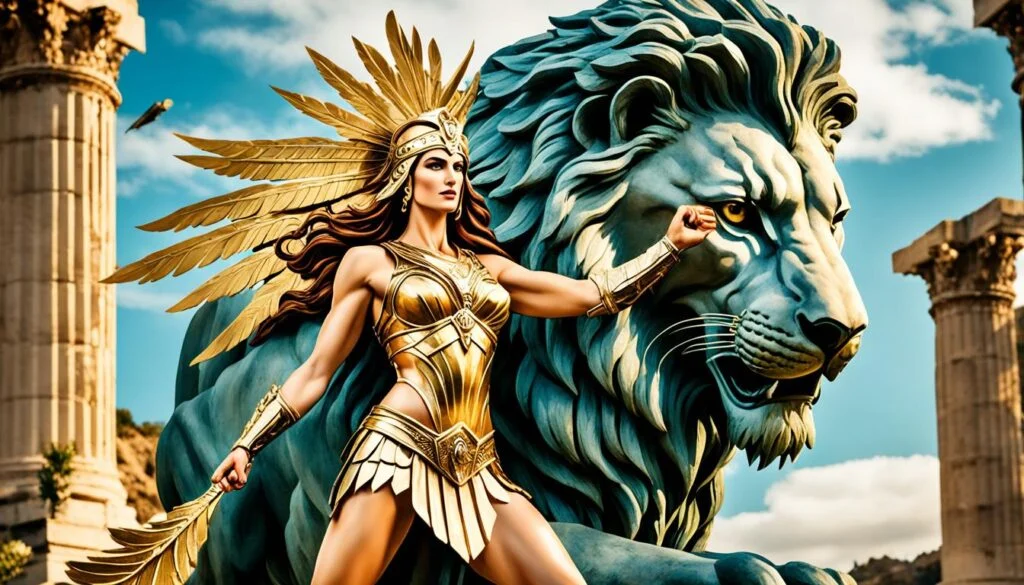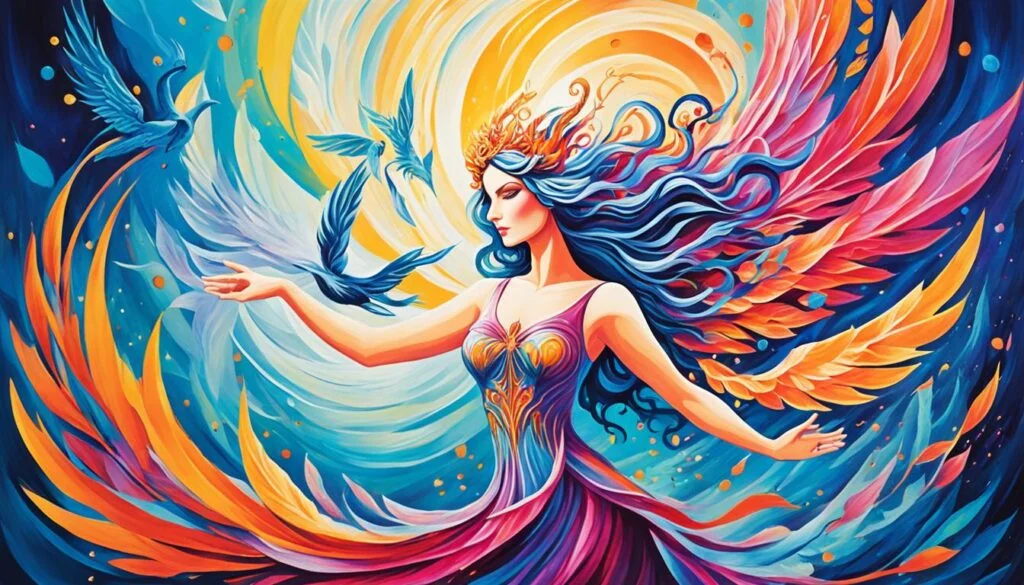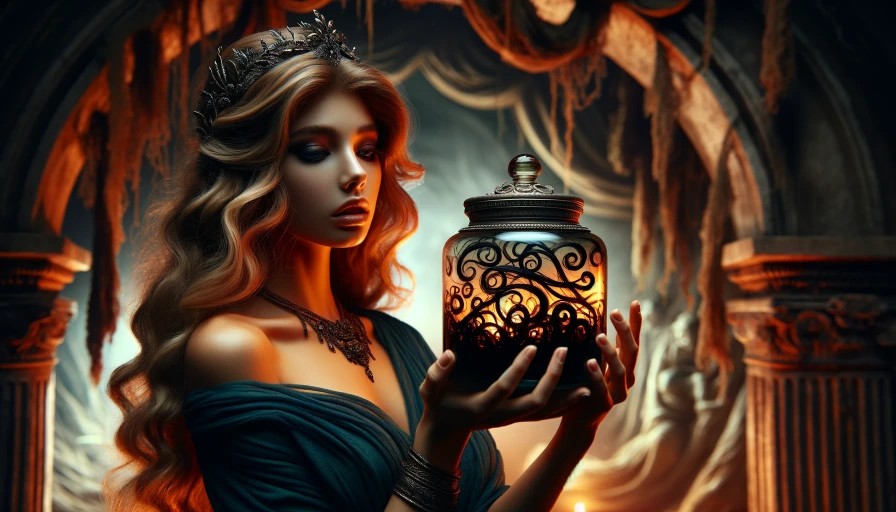Leda remains one of the most captivating figures in Greek mythology. Renowned as the queen of Sparta, Leda’s mythical narrative involves deception, divine intervention, and pivotal moments that echoed throughout Greco-Roman culture.
Her stories are interwoven with themes of passion, particularly noted in her encounter with Zeus in swan form, leading to the birth of children who played major roles in significant mythological events, such as the Trojan War.
The allure of Leda stems from the blend of human and divine experiences in her myth. Her story is immortalized by art and literature, reflecting the extent of her influence.
From the exquisite fresco depicting Leda and the Swan uncovered in a domus in Pompeii to various other artistic portrayals, her tale has inspired countless renditions across centuries.
In the context of Greek myths, Leda’s encounter with Zeus was characterized by sensuality and transformation.
As discovered in Pompeii, the fresco artistically captures the moment Zeus, in the form of a swan, seduces Leda, which even today sparks intrigue and interest in ancient mythology.
Leda’s role extends beyond her divine encounter; it encompasses her sacred position as a queen and mother.
Often compared with other iconic maternal figures in Greek mythology, such as Hecuba, Leda’s legacy continues to captivate historians and myth enthusiasts.
For more on Hecuba’s role and her connection to Leda, explore further here.
Key Takeaways
- Leda mythology features prominently in Greek myths and art.
- Leda is portrayed as the queen of Sparta and a divine consort of Zeus.
- Her encounter with Zeus as a swan resulted in the birth of influential mythological figures.
- The frescoes discovered in Pompeii showcase the timeless appeal of the Leda myth.
- Leda’s story intertwines themes of passion, divine influence, and royal legacy.
Introduction to Leda: A Key Figure in Greek Mythology
Leda remains one of the most captivating figures in Greek mythology. As the wife of King Tyndareus and the queen of Sparta, she occupies a significant place in mythological narratives. But who was Leda beyond her royal titles?
The Leda story involving Zeus, who transformed into a swan to seduce or rape her, adds layers of complexity and intrigue.
The tale of Leda and the Swan is rich in both art and literature. Renaissance giants like Leonardo da Vinci and Michelangelo have immortalized this myth in their works.
Writers such as William Butler Yeats and Elena Ferrante have also found inspiration in her story, examining themes of beauty and deception.
Integral to Leda’s narrative are the two sets of twins she bore: Castor and Pollux. While Castor was considered mortal, Pollux was believed to be a demigod and the son of Zeus, illustrating the myth’s celestial drama.
The genealogy of Leda Greek mythology further highlights her importance. She was the daughter of King Thestius of Aetolia and gave birth to notable figures like Helen of Troy and Clytemnestra, along with Castor and Pollux.
The enduring theme of Zeus transforming himself for seduction, as seen in Leda’s story, reflects broader motifs within Greek mythology.
Leda’s Ancestry and Royal Lineage
Leda’s genealogy is deeply rooted in Greek mythology, showcasing a lineage of prominent figures.
Born to King Thestius and Eurythemis, Leda’s noble beginnings paved the way for her influential role as Queen of Sparta.
Her royal upbringing significantly influenced Leda’s family dynamics and the legendary stories surrounding her.
Parents: Thestius and Eurythemis
Leda’s parents, Thestius and Eurythemis, were both of high stature, contributing to the illustrious nature of her heritage.
Thestius, a king, and Eurythemis imparted not only royal blood but also the responsibilities and expectations that accompanied such lineage.
This ancestral foundation is often highlighted in the exploration of Leda’s genealogy as it underscores her significant place in mythological history.
Siblings: Althaea and Others
Among her siblings, Althaea stands out, further illustrating the notable ties within Leda’s family.
The connections with siblings like Althaea enrich the narrative of Leda’s background, showcasing a tapestry of relationships that are both complex and legendary.
The interplay among Leda, Althaea, and their other siblings shaped the broader mythos that accompanies their stories.
This examination of Leda’s ancestry encapsulates the essence of her noble lineage, highlighting the key figures like Thestius and Eurythemis who played pivotal roles in shaping the legacy of Leda’s family.
Their stories interweave to form a backdrop that sets the stage for her enigmatic presence in Greek mythology.
The Myth of Leda and the Swan
The myth of Leda and the swan is an iconic tale within Greek mythology, representing themes of divine seduction and intervention.
According to Jenny March (2001), Leda, who was married to Tyndareus, became the mother of seven children; among them, Helen and Polydeuces were the offspring of Zeus, who transformed himself into a swan to seduce her.
Throughout history, the Leda and the Swan myth has been depicted in various art forms, captivating artists from different periods.
From the paintbrushes of Leonardo da Vinci and Michelangelo to the poetic lines of W. B. Yeats, the story has inspired numerous creators.
The timeless nature of the Leda myth can be seen in the works of painters like Peter Paul Rubens, who completed two versions of his painting “Leda and the Swan” in the early 1600s, and Correggio, who painted “Leda with the Swan” between 1531 and 1532.
Michelangelo’s 1530 tempera painting of Leda and the Swan, created for the Duke of Ferrara and later sent to the King of France, stands out as a significant piece.
The painting’s prints, produced by Flemish artist Cornelis Bos, first appeared in 1537, further spreading the myth’s visual representation.
The Zeus Leda transformation story has also been interpreted through modernist lenses, with some poems ambiguously portraying the swan’s actions, focusing on the swan’s nature or even romanticizing the act.
This has led to a diverse range of interpretations, from the works of artists like Paul Cézanne and Cesare da Sesto to small-scale sculptures like that of Bartolomeo Ammannati, influenced by Michelangelo’s designs.
The tale of Leda and the Swan is not without controversy. Interpretations vary, reflecting views of Zeus as an adulterer and rapist, leading to portrayals of Leda as either a victim or, in some male poets’ adaptations, as the instigator.
Female poets, however, often confront the myth by identifying with Leda and empathizing with her plight.
This myth has left an indelible mark on both ancient and post-classical art, continuing to inspire artists across different genres and periods, highlighting the intersection between the mortal world and divine realms through the tale of Leda and the Swan.
Who Was Leda: Understanding Her Role in Greek Mythology

To truly grasp Queen Leda’s significance in ancient Greek mythology, one must delve into her various roles and the myths surrounding her.
So, who was Leda? She was not just the wife of King Tyndareus of Sparta; she played a pivotal role that intertwined mortal and divine realms.
Leda’s influence is felt through her relationships and offspring, each of whom played crucial roles in Greek legends.
Leda’s role in myths extends to being the mother of Helen of Troy and the twins Castor and Pollux.
Her connection with Zeus, who approached her in the form of a swan, led to dramatic outcomes, culminating in the events of the Trojan War.
Understanding Queen Leda’s significance also involves exploring her depiction in art and literature.
From ancient sculptures to Cy Twombly’s modern interpretations, Leda and the Swan remain a compelling subject.
Twombly’s abstract 1962 renditions, measuring 190.5 x 200 cm, mix oil, pencil, and crayon to reflect the intense mythology.
His “Leda and the Swan” painting fetched nearly 53 million dollars in 2017, underscoring the enduring appeal of her story.
These artistic representations offer a layered view of who was Leda and her role in myths, with Twombly’s use of symbolic imagery like hearts and inscriptions that add depth to her legacy.
Leda’s mythology also inspired literary giants like William Butler Yeats, whose sonnet delves into the story’s complex implications.
Thus, understanding Queen Leda’s significance involves not just her narrative but her lasting impact on art, literature, and the broader Greek mythos.
Her story continues to be a source of inspiration, depicting the intricate interplay between gods and humans in ancient lore.
Zeus and Leda: A Divine Encounter
The tale of the Zeus-Leda encounter is one of the most intriguing in Leda mythology.
Zeus, the king of the gods, was known for his numerous relationships with both mortals and immortals, leading to a plethora of offspring.
Among these legends, his pursuit and seduction of Leda stand out for its unique and symbolic elements.
The Swan Transformation
According to divine mating myths, Zeus transformed into a majestic swan to woo Leda, the queen of Sparta.
This disguise was not merely for aesthetic purposes but served as a divine tactic. The elegance and innocence associated with a swan allowed Zeus to approach Leda without arousing immediate suspicion.
The Zeus-Leda encounter culminated in a union that would have far-reaching consequences in Greek mythology.
The Resulting Eggs and Their Significance
After the Zeus Leda encounter, Leda laid one or two eggs, from which emerged several notable figures.
The union with Zeus produced Helen, who would later become known as Helen of Troy, and Pollux, who was immortal. Meanwhile, Clytemnestra and Castor were believed to be the offspring of Leda and her mortal husband, King Tyndareus.
Another version of the myth suggests that the goddess Nemesis laid the eggs following a relationship with Zeus.
The births from these eggs are significant not only for their divine and mortal offspring but also for their symbolic representation.
Castor and Pollux, the latter being immortal, are collectively known as the Dioscuri. Their bond was so profound that when Castor, a mortal, was killed, Pollux chose to share his immortality with his brother.
This act of brotherly love and sacrifice led to their placement in the heavens as the constellation Gemini.
Leda’s mythology thus intertwines themes of mortality and divinity, encapsulated by the extraordinary births resulting from her encounter with Zeus.
Although Leda’s presence in myths diminishes after the birth of her offspring, her legacy continues to be a pivotal element in Greek mythology, especially concerning the Trojan War and the heroic tales of her children.
Leda’s Marriage to Tyndareus, King of Sparta
Leda’s marriage to Tyndareus not only united her with the King of Sparta but also transformed her into a celebrated queen with a blend of mortal and divine obligations.
This union marked the beginning of her influential reign and paved the way for her unique role in Greek mythology.
Life as a Queen
As the queen of Sparta, Leda managed both royal and domestic responsibilities with grace. Despite the kingdom’s patriarchal setup, her influence was evident.
Tyndareus organized various contests to find suitable suitors for their daughter Helen, with Menelaus eventually winning her hand with substantial offerings.
Leda’s beauty and wisdom not only attracted Tyndareus but also ensured the stability and growth of their reign together.
Challenges of Dual Maternity
Leda’s marriage became more complex due to her legendary encounter with Zeus, who appeared to her in the form of a swan.
This divine encounter resulted in the birth of two eggs. From these eggs hatched several of her famous children: Helen and Polydeuces from Zeus, and Castor and Clytemnestra from Tyndareus.
This dual maternity presented significant challenges, intertwining divine intervention with human lineage and further complicating Leda’s legacy.
The dual maternity scenario underscored the complexities faced by Leda as she balanced her duties as both a mother to children of divine origin and a queen responsible for continuing the Spartan lineage.
Her story illustrates the intricate tapestry of myth, royalty, and motherhood in ancient Greek culture.
The Story of Leda’s Children
Leda’s children are some of the most remarkable figures in Greek mythology. Each brings a unique story that intertwines fate, beauty, and tragedy, shaping the mythological landscape.
Helen: The Most Beautiful Woman
Helen of Troy, known as “the face that launched a thousand ships,” is perhaps the most famous of Leda’s children.
As the daughter of Zeus and Leda, her beauty became legendary, leading to her abduction by Paris and sparking the Trojan War as recounted in The Iliad.
This iconic tale highlights the far-reaching impact of Helen’s allure and her significant role in Greek mythological history.
The Dioscuri: Castor and Pollux
The Dioscuri twins, Castor and Pollux, are celebrated for their bravery and fraternal bond.
As sons of Leda, they embodied heroism and loyalty, achieving renowned status in many heroic endeavors.
Their story is one of unity and strength, underscoring the powerful ties of brotherhood and the valor they exhibited throughout Greek myths.
Clytemnestra: Tragic Heroine
The Clytemnestra story is a complex and tragic narrative. Twin sister to Helen and daughter of
Leda’s mortal husband, Clytemnestra’s life was marked by profound sorrow and revenge.
Married to King Agamemnon, she bore children who also played pivotal roles in myths, including Iphigenia and Elektra.
Her story is a poignant exploration of betrayal, maternal instincts, and vengeance.
Through their diverse tales, Leda’s children—Helen of Troy, the Dioscuri twins, and Clytemnestra—illustrate the rich tapestry of characters that emerged from Leda’s lineage.
Their narratives have left indelible marks on Greek mythology, portraying a spectrum of human experiences and emotions.
Leda in Art: A Timeless Muse

Throughout Leda’s art history, the myth of Leda and the Swan has been a recurring theme, captivating artists from ancient times to the present.
Leda, as a muse, has inspired numerous artworks that showcase the enduring allure of her story.
Ancient Sculptures and Pottery
Ancient artisans frequently depicted Leda in various mediums, particularly through Leda sculptures and pottery.
These artworks often portrayed the notorious scene of Zeus seducing Leda in the form of a swan, signifying the myth’s profound cultural impact.
Classical sculptures rarely depicted explicit scenes due to prevailing cultural norms, but the story’s essence remained strongly represented.
Renaissance Paintings
The Renaissance period marked a robust revival of interest in Greek mythology, prominently featuring Renaissance Leda depictions.
Renowned artists like Leonardo da Vinci immortalized Leda through their intricate works.
Michelangelo’s portrayal set a transformative standard, leading to numerous adaptations by other artists.
Francois Boucher emphasized the fleshy nuances of Leda, while Tintoretto innovatively depicted her indoors.
Paul Cézanne’s rendition harmonized compositional balance with the swan’s elegance.
Modern Interpretations
Leda’s myth continues to resonate with modern artists who explore varied interpretations. Salvador Dali’s “Leda Atomica” connects the myth to the atomic age, adhering to precise divine proportions.
Cy Twombly’s abstract 1962 version impressively captures motion, reflecting the myth’s dynamic nature.
Marie Laurencin’s portrayal of Leda as a mother diverges from traditional themes, while contemporary female artists delve into themes of violation and rage.
Bjork’s 2001 Oscar dress, however, remains an infamous and peculiar reimagining of the Leda myth.
The Nemesis Theory: An Alternative Origin of Helen
The Nemesis theory offers a fascinating alternative to the traditional Helen origin myth.
Instead of attributing Helen’s conception to Leda, this theory places the goddess Nemesis at the heart of the tale.
It dives into the persistent *amorous pursuits* of Zeus, emphasizing the divine complexities behind Helen’s lineage.
According to the Nemesis theory, Nemesis was transformed into various animals to avoid Zeus’s advances.
Finally, she became a swan. Zeus, adept at transformations himself, saw through the disguise and transformed into a swan as well.
This myth poser asserts that from this divine union, an egg was laid, which later hatched to reveal Helen, the most beautiful woman in the world.
This variation of Helen’s origin not only adds richness to her character but also shifts the spotlight onto the often-overlooked goddess Nemesis.
It underscores the complexity within Greek mythology and offers an alternative to the widely accepted Leda mythology alternatives.
This theory further solidifies Helen’s status as a pivotal figure in both human and divine realms.
By introducing Nemesis into the narrative, the story of Helen intertwines with more obscure aspects of Greek mythology, enriching the cultural understanding of this era. Such tales reflect the multi-faceted nature of myths, born from an intricate weave of stories passed down through generations.
Overall, the Nemesis theory is an intriguing variant, providing deeper insight into the Helen origin myth.
It expands the traditional narrative, presenting fresh perspectives that harmonize the mortal and immortal elements of Helen’s story, enlightening us on the diverse roots of Leda mythology alternatives.
Leda’s Transformation into the Goddess Nemesis

Leda, a key figure in Greek mythology, underwent a fascinating transformation into the goddess
Nemesis symbolizes her immense influence and the complex interplay of mortal and divine realms.
This transformation is often regarded as a poignant conclusion to her eventful life, epitomizing her contributions and hardships.
The transformation of Leda into the goddess Nemesis epitomizes the concept of Greek divine ascension, where mere mortals ascend to divinity.
This metamorphosis is a testament to Zeus’s acknowledgment of Leda’s trials and the significant roles she played within the pantheon of Greek myths.
In these tales, Leda’s transformation into Nemesis resonates deeply, illuminating her lasting impact on the mythological narrative.
Various versions of the myth highlight Leda’s transformation, showcasing the diverse interpretations of her divine journey.
Echoing her significance, more than two dozen examples of the statue of Leda and the Swan survive, underscoring the myth’s popularity, especially among the Romans.
In some accounts, the pursuit of Nemesis by Zeus, disguised in various animal forms, mirrors the themes present in Leda’s story, seamlessly intertwining their fates.
The intricate connection between Leda and Nemesis offers rich material for artists and historians alike.
Renowned figures such as Leonardo da Vinci and Michelangelo, moved by the myth’s profound elements, immortalized Leda’s narrative in their exceptional works.
This fascination continued well into the 20th and 21st centuries, inspiring modern and contemporary artists like Paul Cézanne and Cy Twombly to reinterpret the tale.
In essence, Leda’s transformation into the goddess Nemesis encapsulates the duality of her existence—a blend of mortal struggles and divine reverence.
This culmination not only solidifies her place in the Greek mythological pantheon but also showcases the timeless allure of her story, bridging classical and contemporary interpretations.
Leda’s Legacy in Literature
The story of Leda has been immortalized in various literary works, showcasing her significant impact across different eras.
The Leda literary legacy is profound, with notable mentions in both ancient and modern texts, illustrating the timelessness of her myth.
Homer’s Iliad
Leda is referenced prominently in Homer’s Iliad, where her daughter, Helen, plays a pivotal role in the narrative that launched a thousand ships.
The epic poem underscores the dramatic consequences of divine interactions, hinting at Leda’s importance in the grander mythological scheme.
Ovid’s Metamorphoses
Ovid’s Metamorphoses offers a poetic rendition of the infamous encounter between Zeus and Leda, capturing the transformation and its aftermath with striking imagery.
The detailed account of Zeus morphing into a swan to seduce Leda adds to the rich tapestry of myths documented in this classical work, further cementing the Leda literary legacy.
Modern Literary References
Moving to contemporary literature, Leda has inspired numerous writers and poets. William Butler Yeats’ poem “Leda and the Swan” delves into the complexities of her experience with stark and evocative language, highlighting themes of power and transformation.
The modern interpretations not only enhance the Leda literary legacy but also reflect ongoing societal and cultural dialogues about mythology’s relevance.
Additionally, the novel Love, Leda by Mark Hyatt offers a fresh perspective on Leda’s myth, portraying her as a complex character navigating social and sexual boundaries.
Published by Peninsula Press, this modern narrative underscores the enduring influence of Leda references in enriching the literary landscape.
Early copies of this book even include a limited edition map of Leda’s London haunts, offering readers a tangible connection to her world.
Significance of Leda’s Myth in Greek Culture
The mythological impact of Leda is deeply ingrained in Leda Greek culture, serving as a testament to the intense interplay between beauty, power, and divine intervention.
Leda, often referred to as Thestias, was the daughter of the Aetolian King Thestius and became the queen of Sparta through her marriage to King Tyndareus.
Their union produced famous figures such as Helen of Troy, Clytemnestra, Castor, and Pollux, each carrying significant weight in Greek mythology.
The story of Leda and the Swan, where Zeus transforms into a swan to seduce her, is one of the most well-known myths.
The resulting offspring, like the beautiful Helen and the heroic twins Castor and Pollux, highlight Leda’s significance in mythological tales.
These narratives reveal the complexities of divine relationships and their impact on mortal lives, echoing the prevailing cultural values of ancient Greece.
Various accounts differ concerning the parentage of Leda’s children, with inconsistencies regarding which were mortal and which were of divine origin.
Nonetheless, the consensus often points to Zeus fathering Helen and Pollux, adding a layer of divinity to their roles in history and legend.
This ambiguity in Leda’s children’s lineage underscores her myth’s rich and multifaceted nature.
Leda’s myth has had a lasting mythological impact on art and literature. From ancient sculptures and pottery to Renaissance paintings by artists like Leonardo da Vinci and Michelangelo, the narrative has inspired numerous creative works.
In modern times, literary figures such as William Butler Yeats and Elena Ferrante continue to explore and reinterpret Leda’s story, demonstrating its enduring relevance.
The repeated depiction of Leda in various forms of art supports the notion that her myth was not just a tale of divine escapades but a reflection of broader societal norms and beliefs in ancient Greece.
From the portrayal of beauty and seduction to the exploration of power dynamics between gods and mortals, Leda’s myth resonates through time, highlighting its significance in Greek culture.
In conclusion, Leda’s myth symbolizes key aspects of Leda Greek culture—beauty, power, and divine-human interaction, and its mythological impact is evident in the rich array of artistic and literary works it has inspired.
The story of Leda continues to hold relevance, providing insight into the values and conflicts of an ancient society that still captivates the imagination today.
Leda’s Symbolism and Emblems
Throughout history, the myth of Leda has captured the imagination of many, largely due to its rich symbolism and intriguing emblems.
From the Renaissance period around 1500 to contemporary portrayals, artists, and writers have continually been drawn to the captivating elements within her story.
The Swan as a Symbol
The swan emblem holds significant meaning in the myth of Leda and Zeus. It represents transformation and divinity, illustrating Zeus’s disguise to seduce or deceive mortals.
This transformation emphasizes the dual nature of the divine and the mortal realm, a recurring theme in many Greek myths.
The Leda symbolism surrounding the swan has inspired renowned artists like Leonardo da Vinci and Correggio to depict its mystique in their works.
Examples are Rubens’ versions in Germany and Great Britain and a modern interpretation in Berlin using fluorescent tubes.
The Egg as a Symbol
The egg as a symbol in Leda’s story captures the uniqueness of her childbirth. Unlike typical human births, the egg signifies a celestial or divine birth, underscoring the extraordinary nature of her offspring.
This symbolism is reflected in various artistic renditions, from ancient sculptures in Rome and Florence to modern interpretations like Kati Zorn’s porcelain artworks in Germany.
Fascination with this part of her narrative is seen in many art forms, including a bronze sculpture in Copenhagen and humorous interpretations, like the joke sculpture in front of Oslo’s City Hall.
In sum, the Greek myth symbolism surrounding Leda, embodied by the swan emblem and the egg, has profoundly affected art and literature.
These symbols invite viewers to ponder the deeper meanings of transformation, divine intervention, and the mysteries of birth, continuing to inspire creators across centuries.
Leda’s Role in the Trojan War
Leda, known as Helen’s mother, plays an integral role in the narrative of the Trojan War.
Her indirect involvement had far-reaching consequences, marking her as a critical figure in Greek mythological wars.
Helen’s abduction by Paris not only led to the famous ten-year conflict but also highlighted the complex interplay between divine and mortal realms.
Leda’s union with Zeus, resulting in the birth of Helen from an egg, set the stage for one of history’s most legendary wars.
The Leda Trojan War connection is further solidified by her other children—Castor and Pollux—who, as the Dioscuri, were revered for their heroism.
Though their roles in the war varied, their presence emphasizes the depth of Leda’s impact on Greek mythological wars.
Even Clytemnestra’s actions, stemming from the aftermath of the war, underscore the lasting influence of Leda and her lineage.
The legacy of Leda is often depicted in ancient art, showing her with her children, which reinforces her pivotal role in the fabric of these mythological events.
Her portrayal in stories and artworks through the ages cements her status as a figure whose influence, though subtle, was profound.
Thus, through her daughter Helen, Leda’s indirect but crucial role in the Trojan War remains a cornerstone of epic narratives and Greek cultural heritage.
Conclusion
Reflecting on Leda’s enduring legacy, it’s evident that her multifaceted character extends far beyond her mythic origins.
As the Spartan Queen Leda, she bridges the gap between mortal realms and divine interventions.
Her encounter with Zeus and the subsequent birth of Helen not only paved the way for the catastrophic events of the Trojan War but also positioned her as a vital figure in Greek mythology.
The long-standing cultural impact of Leda is well-documented in literary works, such as William Butler Yeats’ poem ‘Leda and the Swan,’ where Yeats vividly encapsulates the complex and provocative nature of her story within the compact form of a sonnet.
Leda’s myth continues to resonate through various forms of art and literature, reinforcing her as an enduring cultural muse.
Figures like Yeats, who meticulously revised his poem through multiple stages, showcased how Leda’s narrative could inspire deep artistic refinement and exploration.
Furthermore, playwrights like Euripides and Aristophanes, with their respective reinventions of Leda’s offspring Helen, highlight how her legacy intertwines with themes of war, motherhood, and societal expectations, adding layers of depth to her depiction.
In wrapping up this exploration of Leda’s story, one sees a character marked by strength, complexity, and significant influence.
Whether through the timeless verses of the Iliad and the Odyssey or the enduring symbols found in art and modern literature, Leda remains a pivotal figure in the mythological and cultural landscapes.
This Greek mythology wrap-up underscores that Leda’s legacy as both a human and divine entity will continue to captivate and inspire for generations to come.
Frequently Asked Questions
What is the story of Leda?
Leda was a queen of Sparta in Greek mythology who was seduced by Zeus in the form of a swan. As a result of this encounter, she laid two eggs, from which hatched Helen of Troy, Clytemnestra, and the twin brothers Castor and Pollux.
What is Leda the goddess of?
Leda was not actually a goddess in Greek mythology. She was a mortal woman, the queen of Sparta, who became famous for her encounter with Zeus.
What is the significance of Leda and the Swan?
The story of Leda and the Swan is significant as it represents the union of divine and mortal, resulting in the birth of legendary figures. It has been a popular subject in art and literature for centuries, symbolizing themes of power, desire, and transformation.
Who was the father of Leda in Leda and Swan?
Leda’s father was Thestius, the king of Aetolia. Thestius was a son of Ares and Demonice in Greek mythology.
What is the controversy with Leda and the Swan?
The controversy surrounding Leda and the Swan stems from its depiction of a non-consensual encounter between Zeus and Leda. Modern interpretations often view it as a representation of sexual assault, raising questions about power dynamics and consent in mythology.
What happened to Leda after the Swan?
After her encounter with Zeus as a swan, Leda laid two eggs and continued her life as the queen of Sparta. She raised her children, including those born from the eggs, alongside her husband Tyndareus.
Who did Leda give birth to?
Leda gave birth to Helen of Troy, Clytemnestra, and the twin brothers Castor and Pollux. In some versions of the myth, Helen and Pollux were considered immortal children of Zeus, while Clytemnestra and Castor were mortal children of Tyndareus.




